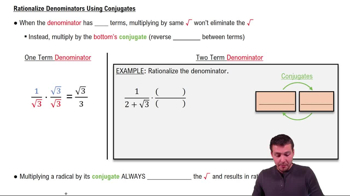Table of contents
- 0. Review of College Algebra4h 43m
- 1. Measuring Angles39m
- 2. Trigonometric Functions on Right Triangles2h 5m
- 3. Unit Circle1h 19m
- 4. Graphing Trigonometric Functions1h 19m
- 5. Inverse Trigonometric Functions and Basic Trigonometric Equations1h 41m
- 6. Trigonometric Identities and More Equations2h 34m
- 7. Non-Right Triangles1h 38m
- 8. Vectors2h 25m
- 9. Polar Equations2h 5m
- 10. Parametric Equations1h 6m
- 11. Graphing Complex Numbers1h 7m
0. Review of College Algebra
Rationalizing Denominators
Problem 11
Textbook Question
Find the domain of each rational expression. See Example 1. x + 3 x - 6
 Verified step by step guidance
Verified step by step guidance1
Identify the rational expression: \( \frac{x + 3}{x - 6} \).
Recall that the domain of a rational expression is all real numbers except where the denominator is zero.
Set the denominator equal to zero to find the values that are not in the domain: \( x - 6 = 0 \).
Solve the equation \( x - 6 = 0 \) to find the value of \( x \) that makes the denominator zero.
Exclude the value found in the previous step from the domain of the rational expression.
Recommended similar problem, with video answer:
 Verified Solution
Verified SolutionThis video solution was recommended by our tutors as helpful for the problem above
Video duration:
2mPlay a video:
Was this helpful?
Key Concepts
Here are the essential concepts you must grasp in order to answer the question correctly.
Rational Expressions
A rational expression is a fraction where both the numerator and the denominator are polynomials. Understanding rational expressions is crucial because their behavior, particularly regarding domain, is influenced by the values that make the denominator zero, which would make the expression undefined.
Recommended video:

Rationalizing Denominators
Domain of a Function
The domain of a function refers to the set of all possible input values (x-values) for which the function is defined. For rational expressions, the domain excludes any values that cause the denominator to equal zero, as these values would lead to undefined expressions.
Recommended video:

Finding the Domain of an Equation
Finding Restrictions
To determine the domain of a rational expression, one must identify the values that make the denominator zero. This involves solving the equation formed by setting the denominator equal to zero and excluding these solutions from the domain, ensuring that the expression remains valid.
Recommended video:

Finding the Domain of an Equation

 2:9m
2:9mWatch next
Master Introduction to Trigonometry with a bite sized video explanation from Nick Kaneko
Start learningRelated Videos
Related Practice




